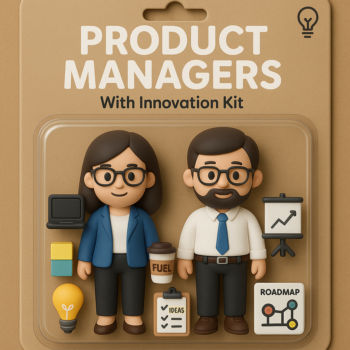
Innovation isn’t what you think it is. While we celebrate products like the iPhone and ChatGPT as breakthrough innovations, they really represent the convergence of countless innovations across multiple dimensions and decades.
Example: the iPhone
Take the incredible iPhone. What appears as a single revolutionary product is built upon decades of innovation across many areas:
- Battery technology: From bulky lead-acid batteries to compact lithium-ion cells capable of powering a sophisticated device all day
- Display technology: The evolution of touch screens from clumsy resistive interfaces to responsive capacitive displays
- Miniaturization: Decades of progress in semiconductor manufacturing to create powerful processors that fit in your pocket
- Wireless technology: The development of cellular networks, WiFi, GPS and Bluetooth to enable seamless connectivity
- Materials science: Advances in glass manufacturing, aluminium processing, and protective coatings
Example: ChatGPT
Similarly, the amazing ChatGPT, while appearing to burst onto the scene, stands on the shoulders of decades of incremental progress:
- Natural Language Processing: Years of research in understanding and generating human language
- Neural Networks: Evolution from simple perceptrons to sophisticated transformer architectures
- Computing Power: Massive improvements in processing capabilities and parallel computing
- Training Data: Development of web crawling, data storage, and content digitization
- Optimization Techniques: Advances in model training, fine-tuning, and computational efficiency
These examples remind us that some of the most impactful innovations come from understanding and improving multiple dimensions of technology and user experience.
Personal example from Product Focus: Catalyst
Let me share a personal example that illustrates this multi-dimensional view of innovation.
At Product Focus, we’ve built a reputation for delivering highly-rated product management training courses—receiving many 5* ratings from delegates. You might think innovation here would mean creating more course modules or adding new content. But our breakthrough came from understanding a different dimension entirely.
Through conversations with business leaders, we realized something crucial: they weren’t just investing in training—they wanted transformation and better business impact as a result. The real opportunity for innovation wasn’t in the core training content, but in how that learning translated into workplace performance.
This insight led us to create the Product Focus Catalyst activation service, designed to help product and L&D leaders embed learning into the workplace to maximize their return on training investment. The innovation wasn’t about making our core product (training) incrementally better—it was about addressing a different dimension of value creation entirely.
This experience reinforced for me how innovation often comes from looking beyond the obvious dimensions of improvement – which is often a new feature, Which brings me to a fascinating paper I recently discovered that explores this concept in depth.
The many faces of innovation
“The Many Faces of Innovation” by Jorge Mestre-Ferrandiz, Arik Mordoh and Jon Sussex isn’t about software products or consumer electronics. Instead, it explores innovation in pharmaceutical development—but don’t click away just yet. The insights it offers about how innovation works are surprisingly relevant for product managers in any industry.
The paper presents a compelling case that innovation isn’t binary—it’s not a simple choice between “breakthrough” and “incremental.” Instead, innovation operates along multiple dimensions simultaneously, creating value in ways that might not be immediately obvious. For those of us tasked with driving innovation in our products, this perspective offers both relief and opportunity.
Understanding the innovation spectrum
The first breakthrough in thinking comes from understanding that innovation exists on a spectrum. Most of us instinctively categorize innovations as either “breakthrough” or “incremental”—with breakthrough innovations getting all the news and glory. This binary thinking can be paralyzing. It suggests that unless we’re creating the next revolutionary product, we’re not really innovating at all.
The reality is far more nuanced and, frankly, more encouraging. Let’s first look at some examples from the paper and then some dimensions of innovation.
Learning from real-world examples
Let’s examine a few case studies from the paper that illustrate innovation in multiple dimensions, that offer some powerful lessons for product managers.
Case study: antihistamines
Consider the evolution of antihistamines—medications for treating allergies. The first generation of these drugs worked well for allergies but had a major drawback: they made people extremely drowsy. The second generation solved the drowsiness problem but required multiple doses per day. The third generation maintained the non-drowsy benefit while requiring just one dose per day.
None of these individual steps was revolutionary in isolation. But together, they transformed a medication from something that treated allergies but impaired daily function, into one that effectively managed symptoms while fitting seamlessly into users’ lives. This is innovation in action—not through a single breakthrough, but through thoughtful improvements across multiple dimensions of the user experience.
Case study: HIV treatments
Consider the evolution of HIV treatments. Early medications required patients to take multiple pills several times per day, had significant side effects, and were difficult to safely combine with other necessary treatments. Over time, improvements occurred across multiple dimensions:
- Core performance: Better effectiveness at controlling the virus
- User experience: Reduced from multiple daily doses to once-daily regimens
- Safety: Fewer side effects and drug interactions
- Cost: More efficient production leading to greater accessibility
- Ecosystem impact: Better compatibility with other medications
For product managers, this translates into valuable lessons about how innovation can compound:
- Core performance solves problems
- Like more effective medicine to control a virus, products that better solve user problems are fundamental to your market success.
- Example: Improved noise cancellation algorithms and sound isolation in noise-cancelling headphones.
- User experience drives adoption
- Just as simpler dosing regimens improved medication adherence, reducing user friction often matters more than adding features.
- Example: How the simple interface of Slack® drove adoption despite internet relay chat (IRC) having similar core functionality.
- Ecosystem thinking matters
- Like medications that work better together, products that play well with others create more value
- Example: Figma® had real success through seamless real-time design collaboration features and a plugin ecosystem
- Safety and reliability build trust
- Reducing side effects in medicine is like improving reliability in software
- Example: How Zoom® video collaboration gained market share through simple, reliable performance.
- Cost innovation expands markets
- More efficient production in pharmaceuticals parallels operational efficiency in technology.
- Example: How Amazon® Web Service’s economies of scale enabled new business models.
The key insight is that meaningful innovation often comes from orchestrating improvements across multiple dimensions rather than breakthrough moments in just one area.
Example dimensions of innovation
The paper identifies several key dimensions where innovation can occur. Let me translate these into areas that product managers can potentially use:
Core performance
Think of this as the “does it work better?” dimension. For antihistamines, this meant better effectiveness at treating allergies. For your product, it might mean faster performance, better accuracy, or improved core functionality. But notice—this is just one dimension among many.
User experience
This is about how people interact with your product. The shift from multiple daily doses to once-daily medication wasn’t about the medicine working better—it was about making it fit better into users’ lives. In product terms, this might mean reducing the number of steps in a workflow or making a complex feature or process more intuitive.
Safety and reliability
For medications, this means fewer side effects. For your product, it might mean better error handling, improved data security, or more consistent performance under variable conditions. Innovation in this dimension builds trust and reduces user anxiety.
Cost and efficiency
Innovation doesn’t always mean adding features. Sometimes it means delivering the same value more efficiently. This could be through improved production processes, smarter resource usage, or business model innovation that makes your solution more accessible to users.
Ecosystem impact
This dimension considers how your product affects the broader system it exists within. Does it integrate better with other tools or systems? Can it make related processes more efficient? Might it create new opportunities for partners or complementary solutions?

You can innovate in several dimensions – it’s not just about new features.
Finding your innovation opportunities
The power of thinking in multiple dimensions lies in how it expands our thinking about where innovation can occur. Instead of asking “How can we revolutionize this market?”, we can ask more focused (and manageable) questions like:
- What core improvements might drive value?
- Which dimension currently causes the most friction for our users?
- Where are we leaving value on the table?
- What small improvements could compound into significant user benefits?
- How might improvements in one dimension enable improvements in others?
Consider running a simple exercise: Map your product against each innovation dimension, rating your current performance and identifying potential improvements. You might discover opportunities you’ve been overlooking while searching for that elusive breakthrough.
Building a Portfolio Approach
One of the paper’s most valuable insights is that successful innovation often comes from maintaining multiple initiatives across different dimensions – like different runners in a race. Think of it as an investment portfolio:
- High-risk, high-reward initiatives (your potential game-changing breakthroughs)
- Medium-risk, medium-reward improvements (significant feature enhancements)
- Low-risk, steady-return optimizations (continuous improvement in existing capabilities)
This balanced approach helps maintain steady progress while still pursuing a few bigger opportunities. It also provides regular wins to demonstrate momentum and value creation to stakeholders.
The economics of incremental innovation
The paper offers a fascinating economic insight that challenges conventional wisdom about innovation and business value. While breakthrough innovations get the headlines, incremental improvements often drive substantial economic returns.
For instance, the paper reveals that for the top 20 best-selling drugs in the US in 1993, by 1995 40% of their revenues came from secondary indications—additional drug uses that were discovered after initial launch. Similarly, in the UK, 25% of revenues for top medications came from improvements and new uses found after initial release. This isn’t just about pharmaceuticals—it’s a pattern we see across industries. In-life product management after launch really matters!

In-life product improvements can drive substantial economic returns
Think about Microsoft® Office. While its initial launch was revolutionary, it’s the accumulated improvements over decades—from user interface refinements to cloud integration—that have sustained its roughly $55 billion annual revenue (2024). Or consider how Apple® expanded its market and revenue opportunity by enabling AirPod™️ Pros to help people with hearing problems.
The economics of incremental innovation are compelling for several reasons:
- Lower risk profile
- Smaller improvements carry less technical and market risk
- Faster time to market means quicker feedback and revenue
- Easier to adjust course based on market response
- Compound returns
- Each improvement builds on previous ones
- User satisfaction and loyalty grow with consistent progress
- Network effects strengthen with each enhancement
- Market expansion
- New use cases emerge from incremental improvements
- Different user segments become accessible
- Geographic expansion becomes possible
- Competitive advantage
- Continuous improvement creates barriers to entry
- Market leadership is maintained through accumulated advances
- Customer switching costs increase over time
This economic reality suggests that while we should remain open to breakthrough opportunities, we shouldn’t undervalue the power of systematic, multi-dimensional improvement. The compound effect of well-executed incremental innovation can be just as valuable as a single breakthrough—and may come with less risk and cost.
When considering your innovation strategy, you might focus on:
- Cumulative impact across dimensions
- Compounding benefits over time
- Risk-adjusted return on investment
- Strategic positioning advantages
The path forward
Innovation doesn’t have to be intimidating, despite it being an uncertain activity with the risk of failure—this is the unavoidable nature of the activity. By understanding its multiple dimensions and taking a portfolio approach to improvements, you can create significant value without hoping for revolutionary breakthroughs.
Key Takeaways:
- Innovation operates along multiple dimensions simultaneously
- Value can be created through thoughtful improvements in any dimension
- A portfolio approach balances risk and reward
- Success comes from consistent progress across dimensions
- Small improvements can compound into significant advantages
Every major innovation we celebrate today—from smartphones to AI chat—evolved through countless improvements across multiple dimensions. Your role as a product manager doesn’t have to be to revolutionize your industry overnight (although that would be nice 😀), but to consistently identify and capture opportunities to create value across different dimensions of your product.
Final thoughts
Coming full circle from where we began, innovation isn’t just about breakthrough moments. It’s about maintaining a clear vision of customer value creation while systematically improving across multiple dimensions. By expanding our view of what constitutes innovation and value, we open new opportunities to create meaningful improvements for our users and businesses.
The next time someone tells you to “be more innovative,” remember that you have multiple dimensions to work with. Focus on understanding where and how you can create the most value and let that guide your innovation efforts.
Your experience?
Please let us know what you think. What’s your experience with innovation (good or bad)?
Eddie Pratt
Managing Director, Product Focus
Note: All trademarks belong to their respective owners.




Leave a comment